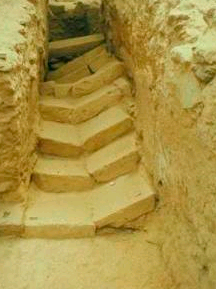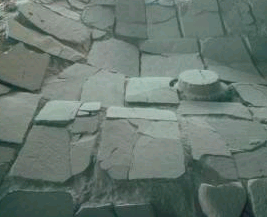Akrotiri is the Greek version of Pompeii, which we all know was buried by the eruption of Mount Vesuvius in AD79. I believe Akrotiri to be more exciting than its Roman cousin, perhaps not in size or fame but definitely for the age of the town, the beauty of some of the finds and the violence of the volcanic eruption! I will obviously provide details of all this to you later.
The site was uncovered during construction of the Suez Canal in 1860. Accidently, as so many archaeological finds are! The ash from the island of Santorini was being quarried and purely by chance the workers stumbled across this amazing place.
Due to this Akrotiri is sometimes referred to as the “Minoan Pompeii”.
From the many Frescoes depicting busy harbour scenes at Akrotiri, the size and complexity of the buildings and the finds revealed, it can be safely said that this port was an extremely busy and prosperous one.
There was a settlement on the site from at least 3,000BC, although evidence of occupation dating as far back as the late Neolithic (4,000BC) has been recovered from the site, the town itself wasn’t buried until 1450 BC, which makes the site a lot older than Pompeii (as you recall one of the reasons I rate Akrotiri so much!)
THE MINOANS, a brief introduction
It wouldn’t be fair to just launch into the good stuff without a little background to these amazing people, but I’ll keep it brief (nobody reads this part anyway!).
THE MINOANS, the palace civilisation of the Aegean
Richard Hooker
You must admit that they sound like a civilised, enlightened and advanced society.
Using Google Earth let me show you where in the Mediterranean this island is located.
A map of Ancient Greece and the Island of Thera with respect to other Greek Islands can be found HERE.
For those interested in further information regarding the Minoans, here are some links:
THE LAND
THE HISTORY OF THE MINOANS
MINOAN RELIGION
WOMEN IN THE MINOAN CULTURE
EARTHQUAKES, EVACUATION & ERUPTION of THERA
http://www.abovetopsecret.com/forum/thread547617/pg1
Archaeologists suspected that the town had been evacuated well before the volcanic eruption buried it. Why? Firstly, unlike Pompeii there was distinct a lack of human remains, secondly archaeologists found numerous examples of damaged buildings determined to be unrelated to the “final” eruption.
STEPS SHOWING EARTHQUAKE DAMAGE
Theories on the time between the last earthquake and eventual evacuation vary, from a mere three months to three decades. What is known for definite is the town was built in a very unstable area, by the time it was buried under ash and lava, the locals had taken the hint and moved on.
STONE FLOOR SHOWING EARTHQUAKE DAMAGE
The site at Akrotiri has yielded just a single item of precious metal, indeed there is an obvious lack of materially valuable goods which further points to an extensive evacuation effort on behalf of the Minoans inhabiting the town.
GOLD IBEX (the only precious metal find)
CONTINUED





No comments:
Post a Comment